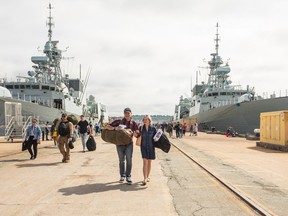Article author:
Canadian Press
Lee Berthiaume

Ottawa — For the first time in eight years, Canadian warships It is not involved with either of the two NATO Naval Task Forces responsible for patrolling European waters and defending against Russia. threat.
This revelation puts the spotlight on what experts say is a growing trade-off with the Royal Canadian Navy. Lack of trained seafarers.
Canada has been a consistent presence in the permanent NATO maritime group since Russia's annexation of Ukraine's Crimea peninsula in 2014, with at least one of her Halifax-class frigates Deployed on a rotating basis in the North Atlantic or Mediterranean.
The liberal federal government emphasized deploying her second frigate in March as part of its response to Russia's invasion of Ukraine. The ship was scheduled for a multi-month deployment in the Indian Ocean and the Middle East.
However, Pentagon spokeswoman Jessica Lamiland said that since HMCS Montreal and her HMCS Halifax returned to their home ports last month, Canada has no frigates belonging to any of her NATO Naval Groups. says no.
"On 15 July she reported that HMCS Montreal and Halifax returned home, so the CAF now has ships manned by either NATO Maritime Group 1 or 2. No," said Lamiland. email. "This is the first time since 2014."
Lamiland combined the decision not to send new frigates to Europe with the deployment of her two such ships to the Asia-Pacific region. Relating to the maintenance and training requirements of the Halifax-class fleet.
Instead, Canada deployed two of her smaller Kingston-class coastal defense ships to work with another of her NATO naval forces focused on finding and clearing enemy mines. increase.
Chief of Defense General Wayne Eyre said it would help Canadian sailors gain experience in key areas of naval warfare while demonstrating Canada's commitment to European security.
But he admitted in an interview with the Canadian Press on Monday. So you have to make decisions about where and when to invest.
He added that he approved the decision to send two of her frigates to the Pacific, where tensions between the West and China are rising. nation. "
China last week launched large-scale military exercises around Taiwan, an autonomous island that Beijing considers its territory, after U.S. House Speaker Nancy Pelosi visited Taipei. The exercise comes amid growing concerns over a possible Chinese invasion.
Timothy Choi, a shipbuilding expert at the University of Calgary, said earlier this year that two frigates were in Europe at the same time. He said the decision to deploy played a major role in constraining the Atlantic Fleet's ability to dispatch another frigate in the short term.
It doesn't mean that crew availability has deteriorated in recent years," he said.
"Rather, it is an inevitable consequence of smaller fleets concentrating more resources into shorter timeframes, resulting in longer recovery times."
However, Canada Global Affairs Institute defense analyst David Perry says Canada will have to make increasingly difficult trade-offs about where to send its warships, given the size and state of its navy.
Canada has 12 frigates, but Perry said the Navy's maintenance and training requirements mean that only a handful can be deployed at any given time. He also had three destroyers in Canada, but these ships were retired in 2014.
Adding to the difficulty is the age of the frigates that entered service in the 1990s. Fixing and maintaining is more difficult, according to both senior officials and internal reports.
“These decisions about trade-offs will become increasingly difficult because we have already experienced this and the maintenance cycles on older ships are more intense and more labor intensive. , because they're getting longer," Perry said.
Former naval officer Adam McDonald, now studying at Dalhousie University in Halifax, said the Navy and the Canadian military were also facing increasing pressure to maintain a presence in Europe, Asia and the Arctic. said to be expected to face
"These will be very pressing issues for him as they are in demand in all three geographic environments," McDonald said. "The Caribbean, West Africa and South America, in addition to other places where we operate." But multi-billion dollar projects have been plagued by cost overruns and repeated delays.
The Navy, like other militaries, is facing severe manpower shortages. minesweepers will continue to add more slack.

Receive the latest headlines, stories, opinions and photos of Toronto His Sun right from the newsroom to your inbox at noon.
Thank you for registering.
Sending welcome email. If you don't see it, please check your spam folder.
The next issue of Your Midday Sun will arrive in your mailbox shortly.


